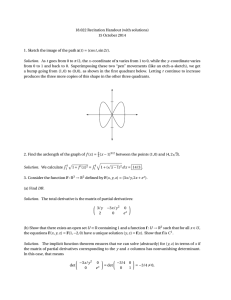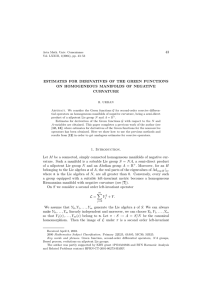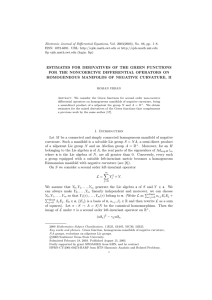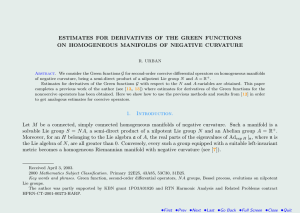Electronic Journal of Differential Equations, Vol. 2004(2004), No. 145, pp.... ISSN: 1072-6691. URL: or
advertisement
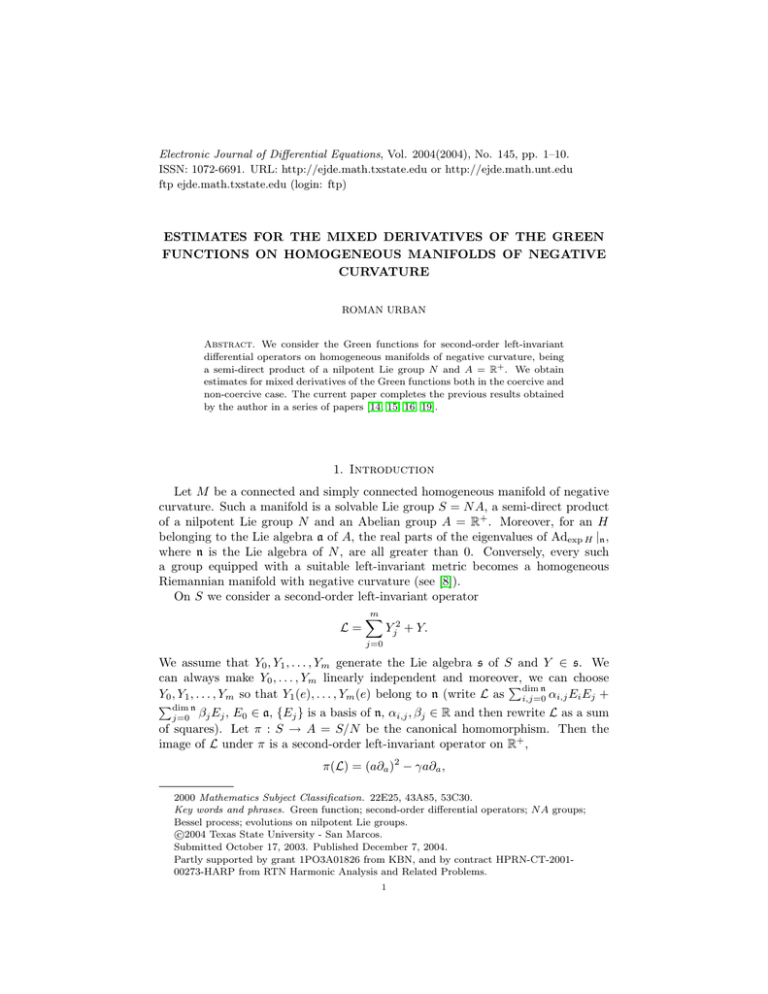
Electronic Journal of Differential Equations, Vol. 2004(2004), No. 145, pp. 1–10.
ISSN: 1072-6691. URL: http://ejde.math.txstate.edu or http://ejde.math.unt.edu
ftp ejde.math.txstate.edu (login: ftp)
ESTIMATES FOR THE MIXED DERIVATIVES OF THE GREEN
FUNCTIONS ON HOMOGENEOUS MANIFOLDS OF NEGATIVE
CURVATURE
ROMAN URBAN
Abstract. We consider the Green functions for second-order left-invariant
differential operators on homogeneous manifolds of negative curvature, being
a semi-direct product of a nilpotent Lie group N and A = R+ . We obtain
estimates for mixed derivatives of the Green functions both in the coercive and
non-coercive case. The current paper completes the previous results obtained
by the author in a series of papers [14, 15, 16, 19].
1. Introduction
Let M be a connected and simply connected homogeneous manifold of negative
curvature. Such a manifold is a solvable Lie group S = N A, a semi-direct product
of a nilpotent Lie group N and an Abelian group A = R+ . Moreover, for an H
belonging to the Lie algebra a of A, the real parts of the eigenvalues of Adexp H |n ,
where n is the Lie algebra of N , are all greater than 0. Conversely, every such
a group equipped with a suitable left-invariant metric becomes a homogeneous
Riemannian manifold with negative curvature (see [8]).
On S we consider a second-order left-invariant operator
L=
m
X
Yj2 + Y.
j=0
We assume that Y0 , Y1 , . . . , Ym generate the Lie algebra s of S and Y ∈ s. We
can always make Y0 , . . . , Ym linearly independent and moreover, we can choose
Pdim n
Y0 , Y1 , . . . , Ym so that Y1 (e), . . . , Ym (e) belong to n (write L as i,j=0 αi,j Ei Ej +
Pdim n
j=0 βj Ej , E0 ∈ a, {Ej } is a basis of n, αi,j , βj ∈ R and then rewrite L as a sum
of squares). Let π : S → A = S/N be the canonical homomorphism. Then the
image of L under π is a second-order left-invariant operator on R+ ,
π(L) = (a∂a )2 − γa∂a ,
2000 Mathematics Subject Classification. 22E25, 43A85, 53C30.
Key words and phrases. Green function; second-order differential operators; N A groups;
Bessel process; evolutions on nilpotent Lie groups.
c
2004
Texas State University - San Marcos.
Submitted October 17, 2003. Published December 7, 2004.
Partly supported by grant 1PO3A01826 from KBN, and by contract HPRN-CT-200100273-HARP from RTN Harmonic Analysis and Related Problems.
1
2
R. URBAN
EJDE-2004/145
where γ = γL ∈ R. We say that a second order differential operator L on a
Riemannian manifold is non-coercive (coercive resp.) if there is no ε > 0 such that
L + εId admits the Green function (if such an ε exists resp.). It is worth noting that
our definition of coercivity is slightly different than that used e.g. in [1]. Namely,
for us, L is coercive if it is weakly coercive in Ancona’s terminology. There is a
relation between the notion of coercivity property in the sense used in the theory
of partial differential equations (i.e., that an appropriate bilinear form is coercive,
[9]) and weak coercivity. For this the reader is referred to [1].
In this paper we shall study both coercive and non-coercive operators. In this
case L can be written as
X
L = Lγ =
Φa (Xj )2 + Φa (X) + a2 ∂a2 + (1 − γ)∂a ,
(1.1)
j
where γ = γL ∈ R, X, X1 , . . . , Xm are left-invariant vector fields on N , moreover,
X1 , . . . , Xm are linearly independent and generate n,
Φa = Adexp(log a)Y0 = e(log a) adY0 = e(log a)D ,
where D = adY0 is a derivation of the Lie algebra n of the Lie group N such that
the real parts dj of the eigenvalues λj of D are positive. By multiplying Lγ by a
constant, i.e., changing Y0 , we can make dj arbitrarily large (see [5]).
Let Gγ (xa, yb) be the Green function for Lγ . Gγ is (uniquely) defined by two
conditions:
(i) Lγ Gγ (·, yb) = −δyb as distributions (functions are identified with distributions via the right Haar measure),
(ii) for every yb ∈ S, Gγ (·, yb) is a potential for Lγ , i.e, is a positive superharmonic function such that its largest harmonic minorant is equal to zero (cf.
[2]).
Let
Gγ (x, a) := Gγ (e, xa),
(1.2)
where e is the identity element of the group S. Since Lγ is left-invariant it is easily
seen that
Gγ (xa, yb) = Gγ (e, yb(xa)−1 ) = Gγ (yb(xa)−1 ).
In this article we call Gγ (x, a) defined in (1.2) the Green function for Lγ .
The main goal of this paper is to give estimates for derivatives of the Green
function (1.2) for Lγ .
To illustrate the general set up, before we proceed further, we would like to give
a simple and explicit example of the operator L in coordinates. Consider S = Rn ×
R+ . Let d1 , . . . , dn be positive constants. For every a > 0, define Φa (∂xj ) = adj ∂xj .
Then Φa on Rn becomes Φa (x) = Φa (x1 , . . . , xn ) = (ad1 x1 , . . . , adn xn ) and we get
n
on
P R a structure of the homogeneous group with the homogeneous dimension Q =
dj (see [7]). The multiplication law in S is given byP
the formula (x, a)·(y, b) = (x+
Φa (y), ab). In this example the operator (1.1) is L = j a2dj ∂x2j +a2 ∂a2 +(1−γ)a∂a .
R∞
The Green function for L is G((x, a), (y, b)) = 0 pt (x, a; y, b)dt, where pt (x, a; y, b)
is the heat diffusion kernel on S, such that u(t, y, b) := pt (x, a; y, b) is the minimal
solution of Lu = ∂t u, u(0, y, b) = δ(x,a) (y, b) and δ(x,a) (·) stands for Dirac’s delta.
Let us go back to the general setting. We are going to prove (or at least to sketch
the proof of) the following estimates. Let γ ≥ 0. For every neighborhood U of the
EJDE-2004/145
ESTIMATES FOR THE MIXED DERIVATIVES
identity e of N A there is a constant C = C(γ) such that we have
−kIk−Q−γ −k
a
C(|x| + a)
k I
|∂a X G−γ (x, a)| ≤ ×(1 + | log(|x| + a)−1 |)kIk0 for (x, a) ∈ (Q ∪ U)c ,
−k
Ca
for (x, a) ∈ Q \ U
3
(1.3)
and
−kIk−Q−γ γ−k
a
C(|x| + a)
−1 kIk0
k I
×(1
+
|
log(|x|
+
a)
|)
|∂a X Gγ (x, a)| ≤
γ−k
Ca
for (x, a) ∈ (Q ∪ U)c ,
(1.4)
for (x, a) ∈ Q \ U,
where | · | stands for a “homogeneous norm” on N , Q = {|x| ≤ 1, a ≤ 1}, kIk is a
suitably defined length of the multi-index I and kIk0 is a certain number depending
on I and the nilpotent part of the derivation D. In particular, kIk0 is equal to 0 if
the action of A = R+ on N , given by Φa , is diagonal or, if I = 0. X1 , . . . , Xn is an
appropriately chosen basis of n. For the precise definitions of all the notions that
have appeared here see Sect. 2.
It should be said that the estimate for the Green function itself (i.e., I=0) with
γ > 0, also from below, was proved by E. Damek in [4] and then by the author
for γ = 0 in [19] but at that time it was impossible to prove analogous estimate
for derivatives. The reason was that we did not have sufficient estimates for the
derivatives of the transition probabilities of the evolution on N generated by an
appropriate operator which appears as the “horizontal” component of the diffusion
on N × R+ generated by a−2 L−γ (cf. [5]). These estimates have been obtained by
the author in [20] and eventually led up to the estimates for derivatives of the Green
functions in the non-coercive case, i.e., γ = γL = 0 (see [15] for derivatives with
respect to N and A-variables separately and [16] for the mixed derivatives which
required a slightly different approach). Next, in [14] the results from [15] have been
used to get estimates for derivatives in the coercive case. This note completes the
previous works of the author in that we provide a proof of the estimates which is
valid for both the coercive and non-coercive cases.
The proofs of (1.3) and (1.4) require both analytic and probabilistic techniques.
Some of them have been introduced in [6, 5] and [19].
The structure of the paper is as follows. In Sect. 2 we set the notation and give
all necessary definitions. In particular, we recall a definition of the Bessel process
which appears as the“vertical” component of the diffusion generated by a−2 L−γ on
N × R+ as well as the notion of the evolution on N generated by an appropriate
operator which appears as the“horizontal” component of the diffusion on N × R+
mentioned in the above (cf. [5, 15]). Moreover, we state Theorem 2.1 which is the
main tool in the proof of Theorem 3.1.
Finally, in Sect. 3 we state the estimates (1.3), (1.4) precisely (see Theorem 3.1)
and we give a sketch of its proofs.
2. Preliminaries.
N A groups. Good reference for this topic are [6, 5] and [7]. Let N be a connected
and simply connected nilpotent Lie group. Let D be a derivation of the Lie algebra
n of N . For every a ∈ R+ we define an automorphism Φa of n by the formula
Φa = e(log a)D .
4
R. URBAN
EJDE-2004/145
Writing x = exp X we put
Φa (x) := exp Φa (X).
C
Let n be the complexification of n. Define
C
k
nC
λ = {X ∈ n : ∃k > 0 such that (D − λI) = 0}.
Then
n=
M
Vλ ,
(2.1)
Imλ≥0
where
(
C
Vλ̄ = (nC
λ ⊕ nλ̄ ) ∩ n if Imλ 6= 0,
Vλ =
C
nλ ∩ n
if Imλ = 0.
We assume that the real parts dj of the eigenvalues λj of the matrix D are strictly
greater than 0. We define the number
X
X
Q=
Re λj =
dj
(2.2)
j
j
and we refer to this as a “homogeneous dimension” of N . In this paper D = adY0
(see Introduction). Under the assumption on positivity of dj , (2.1) is a gradation
of n.
We consider a group S which is a semi-direct product of N and the multiplicative
group A = R+ = {exp tY0 : t ∈ R} :
S = N A = {xa : x ∈ N, a ∈ A}
with multiplication given by the formula
(xa)(yb) = (xΦa (y) ab).
On N we define a “homogeneous norm”, | · | (cf. [6, 5]) as follows. Let (·, ·) be a
fixed inner product in n. We define a new inner product
Z 1
da
(2.3)
hX, Y i =
Φa (X), Φa (Y )
a
0
and the corresponding norm
kXk = hX, Xi1/2 .
We put
−1
|X| = (inf{a > 0 : kΦa (X)k ≥ 1})
.
One can easily show that for every Y 6= 0 there exists precisely one a > 0 such that
Y = Φa (X) with |X| = 1. Then we have |Y | = a.
Finally, we define the homogeneous norm on N . For x = exp X we put
|x| := |X|.
+
Notice that if the action of A = R on N (given by Φa ) is diagonal the norm we
have just defined is the usual homogeneous norm on N and the number Q in (2.2)
is simply the homogeneous dimension of N (see [7]).
Having all that in mind we define appropriate derivatives (see also [6]). We fix
an inner product (2.3) in n so that Vλj , j = 1, . . . , k are mutually orthogonal and
an orthonormal basis X1 , . . . , Xn of n. The enveloping algebra U(n) of n is identified
with the polynomials in X1 , . . . , Xn . In U(n) we define hX1 ⊗· · ·⊗Xr , Y1 ⊗· · ·⊗Yr i =
EJDE-2004/145
ESTIMATES FOR THE MIXED DERIVATIVES
5
Qr
Let Vjr be the symmetric tensor product of r copies of Vλj . For
I = (i1 , . . . , ik ) ∈ (N ∪ {0})k let
j=1 hXj , Yj i.
(i1 )
X I = X1
(ik )
. . . Xk
(ij )
, where Xj
i
∈ Vj j .
Then for X ∈ Vλj ,
kΦa (X )k ≤ c exp(dj log a + Dj log(1 + | log a|)),
where dj = Reλj and Dj = dim Vλj − 1, and so
kΦa (X I )k ≤ exp
k
X
k
Y
(i )
ij (dj log a + Dj log(1 + | log a|))
kXj j k
j=1
(2.4)
j=1
Bessel process. Let σ(t) denote the Bessel process with a parameter α ≥ 0 (cf.
[11]), i.e., a continuous Markov process with the state space [0, +∞) generated by
2α+1
dy is given
∂a2 + 2α+1
a ∂a . The transition function with respect to the measure y
(cf. [3, 11]) by:
(
1
−x2 −y 2
1
Iα xy
for x, y > 0,
2t exp
4t
2t (xy)α
pt (x, y) =
−y 2
1
for x = 0, y > 0,
2α (2t)α+1 Γ(α+1) exp
4t
where
Iα (x) =
∞
X
k=0
(x/2)2k+α
k!Γ(k + α + 1)
is the Bessel function (see [10]). Therefore for x ≥ 0 and a measurable set B ⊂
(0, ∞):
Z
Px (σ(t) ∈ B) =
pt (x, y)y 2α+1 dy.
B
If σ(t) is the Bessel process with a parameter α starting from x, i.e. σ(0) = x, then
we will write that σ(t) ∈ BESSx (α) or simply σ(t) ∈ BESS(α) if the starting point
is not important or is clear from the context.
Properties of the Bessel process are very well known and their proofs are rather
standard. They can be found e.g. in [11, 5, 18, 17]. However, in our paper we will
not explicitly make use of any particular property of the Bessel process.
Evolutions. Let X, X1 , . . . , Xm be as in (1.1). Let σ : [0, ∞) −→ [0, ∞) be a
continuous function such that σ(t) > 0 for every t > 0. We consider the family of
evolutions operators Lσ(t) − ∂t , where
X
Lσ(t) = σ(t)−2
Φσ(t) (Xj )2 + Φσ(t) (X) .
(2.5)
j
For the main result of the paper we are mainly interested in the operator (2.5) with
σ(t) being a trajectory of an appropriate Bessel process.
Since we assume X1 , . . . , Xm being linearly independent, we select Xm+1 , . . . , Xn
so that X1 , . . . , Xn form a basis of n. For a multi-index I = (i1 , . . . , in ), ij ∈ Z+
and the basis X1 , . . . , Xn of the Lie algebra n of N we write: X I = X1i1 . . . Xnin and
|I| = i1 + · · · + in . For k = 0, 1, . . . , ∞ we define:
C k = {f : X I f ∈ C(N ), for |I| < k + 1}
and
k
C∞
= {f ∈ C k : lim X I f (x) exists for |I| < k + 1}.
x→∞
6
R. URBAN
EJDE-2004/145
k
For k < ∞ the space C∞
is a Banach space with the norm
X
kf kC∞
kX I f kC(N ) .
k =
|I|≤k
Let {U σ (s, t) : 0 ≤ s ≤ t} be the unique family of bounded operators on C∞ =
which satisfy
0
C∞
(i)
(ii)
(iii)
(iv)
(v)
U σ (s, s) = I,
U σ (s, r)U σ (r, t) = U σ (s, t), s < r < t,
∂s U σ (s, t)f = −Lσ(s) U σ (s, t)f for every f ∈ C∞ ,
∂t U σ (s, t)f = U σ (s, t)Lσ(t) f for every f ∈ C∞ ,
2
2
U σ (s, t) : C∞
−→ C∞
.
Note that U σ (s, t) is a convolution operator. Namely, U σ (s, t)f = f ∗pσ (t, s), where
pσ (t, s) is a smooth density of a probability measure. By ii) we have pσ (t, r) ∗
pσ (r, s) = pσ (t, s) for t > r > s. The existence of the family U σ (s, t) follows from
[12].
For α ≥ 0, on a direct product G = N × R+ we consider the following operator
X
2α + 1
Lα = a−2
Φa (Xj )2 + a−2 Φa (X) + ∂a2 +
∂a .
a
j
For f ∈ Cc∞ (G), we define on G the following function
u(t, x, a) := Ea U σ (0, t)f (x, σ(t)),
(2.6)
where the expectation is taken with respect to the distribution of the Bessel process
σ(t) starting from a. The following theorem, which gives the formula for the solution
of the heat equation for Lα in terms of the evolution on N driven by the Bessel
process, is one of the main tool in the proof of our results.
Theorem 2.1. Let u = u(t, x, a) be a function on G defined by (2.6). Then
Lα u = ∂t u, u(0, x, a) = f (x, a).
(2.7)
Moreover, there exists the only one bounded from below solution u of (2.7).
Proof. For the proof of the first part of Theorem 2.1 see [5]. The uniqueness of
the bounded from below solution u follows by some kind of the maximum principle
which is a modification of Theorem. 3.1.1 in [13]. The proof for a diagonal action
given in [17] can be easily generalized.
3. The main result and its proof.
In this section we obtain pointwise estimates for derivatives of the Green function
(1.2).
For a positive δ < 1/2 define
Tδ ={(x, a) ∈ N × R+ : 1 − δ < a < 1 + δ, |x| < δ},
Q ={(x, a) ∈ N × R+ : |x| ≤ 1, a ≤ 1}.
Theorem 3.1. For a multi-index I = (i1 , . . . , ik ), γ ≥ 0, k ∈ Z+ and all operators
(i )
i
(i )
(i )
X I = X1 1 . . . Xk k , where Xj j ∈ Vj j , with kX I k ≤ 1, there are constants C such
EJDE-2004/145
ESTIMATES FOR THE MIXED DERIVATIVES
7
that
−kIk−Q−γ −k
a
C(|x| + a)
k I
|∂a X G−γ (x, a)| ≤ ×(1 + | log(|x| + a)−1 |)kIk0
−k
Ca
for (x, a) ∈ (Q ∪ Tδ )c ,
for (x, a) ∈ Q \ Tδ
and
−kIk−Q−γ γ−k
a
C(|x| + a)
k I
−1
|∂a X Gγ (x, a)| ≤ ×(1 + | log(|x| + a) |)kIk0 for (x, a) ∈ (Q ∪ Tδ )c ,
γ−k
Ca
for (x, a) ∈ Q \ Tδ
Pk
Pk
where kIk = j=1 ij dj , dj = Reλj , and kIk0 = j=1 ij Dj , Dj = dim Vλj − 1.
Let α ≥ 0 and γ ≥ 0. Along with the operator L−γ defined in (1.1) we consider
the corresponding operator Lα ,
X
2α + 1
Lα = a−2
Φa (Xj )2 + a−2 Φa (X) + ∂a2 +
∂a = a−2 L−γ ,
a
j
where α = γ/2. The Green function Gα for Lα is given by
Z ∞
Gα (x, a; y, b) =
pt (x, a; y, b)dt,
0
where
Z
Tt f (x, a) =
f (y, b)pt (x, a; y, b)dyb2α+1 db
is the heat semigroup on L2 (N × R+ , dyb2α+1 db) given by Theorem 2.1 with the
infinitesimal generator Lα .
On N × R+ we define dilations:
Dt (x, a) = (Φt (x), ta),
t > 0.
It is not difficult to check that although the operator Lα is not left-invariant it has
some homogeneity with respect to the family of dilations introduced above:
Lα (f ◦ Dt ) = t2 Lα f ◦ Dt .
This implies that
Gα (x, a; y, b) = t−Q−2α Gα (Dt−1 (x, a); Dt−1 (y, b)).
(3.1)
It turns out (see (1.17) in [5]) that
G−γ (x, a) = Gγ/2 (e, 1; x, a) = G∗γ/2 (x, a; e, 1),
where G∗α is the Green function for the operator
X
2α + 1
∂a
L∗α = a−2
Φa (Xj )2 − a−2 Φa (X) + ∂a2 +
a
j
formally conjugate to Lα with respect to the measure a2α+1 dadx. Moreover,
Z ∞
G∗α (x, a; e, 1) = lim
E1 pσ (t, 0)(x)mα (Ia,η )−1 1Ia,η (σt )dt,
η→0
0
where
Z
mα (I) =
I
a2α+1 da
(3.2)
8
R. URBAN
EJDE-2004/145
and the expectation is taken with respect to the distribution of the Bessel process
with the parameter α starting from 1, i.e., BESS1 (α) on the space C((0, ∞), (0, ∞)),
pσ (t, 0) is the transition function of the evolution generated by the operator (2.5)
and Ia,η = [a − η, a + η].
Since L−γ (·) = a−γ Lγ (aγ ·) it follows that
Gγ (xa, yb) = aγ G−γ (xa, yb)b−γ
(3.3)
and therefore, by (3.2) and (3.3),
Gγ (x, a) = G∗γ/2 (x, a; e, 1)aγ .
Before we go to the proof of our main result we note the following important
proposition which gives estimates on the set Q \ Tδ of some functional of the evolution pσ which plays the crucial role in the proof of Theorem 3.1.
Proposition 3.2. i) For every 1 > δ > 0 and for every multi-index I such that
|I| > 0 there exists a constant C > 0 such that for every (x, a) ∈ (Q \ Tδ ) ∩ {(x, a) ∈
N × R+ : a ≤ 1 − δ} and for every 0 ≤ l ≤ k − 1,
Z ∞
sup |
E1 X I pσ (t, 0)(x)∂al mα (Ia,η )−1 ∂ak−l 1Ia,η (σt )dt| ≤ Ca−k .
0<η<δ/2
0
ii) For every 0 < χ0 ≤ 1, 0 < r0 ≤ 1 and for every multi-index I such that
|I| > 0 there exists a constant C > 0 such that for every χ ≤ χ0 , for every (x, a) ∈
{0 < a ≤ 1, r0 ≤ |x| ≤ 1}, and for every 0 ≤ l ≤ k − 1,
Z ∞
sup |
Eχ X I pσ (t, 0)(x)∂al mα (Ia,η )−1 ∂ak−l 1Ia,η (σt )dt| ≤ Ca−k .
0<η<1
0
iii) For every 1 > δ > 1/2 and for every multi-index I such that |I| > 0 there
exists a constant C > 0 such that for every χ ≤ 1/2 − δ, for every (x, a) ∈ {(1 − δ)/
2 ≤ a ≤ 1/2} and for every 0 ≤ l ≤ k − 1,
Z ∞
sup |
Eχ X I pσ (t, 0)(x)∂al mα (Ia,η )−1 ∂ak−l 1Ia,η (σt )dt| ≤ Ca−k .
0<η<δ/4
0
Sketch of the proof. The case α = 0 has been proved in [16]. (See the proof of
Proposition 3.1 in [16]. We take the opportunity to say that the formulation of
Proposition 3.1 in [16] is wrong and that it should have been stated exactly as
above with α = 0.) The generalization from α = 0 to an arbitrary α > 0 is (almost)
straightforward. One only needs to imitate the proof of Proposition 3.1 in [16]. After this preparatory facts we are ready to give
Sketch of the proof of Theorem 3.1. Let 0 < δ < 1/2, k ∈ Z+ and a multi-index I
be fixed.
Case 1. We consider the set
S1 = Q \ T δ .
By Proposition 3.2 and Theorem 2.1 it follows that there exists a positive constant
C such that
|∂ak X I G∗γ/2 (x, a; e, 1)| ≤ Ca−k
(3.4)
EJDE-2004/145
ESTIMATES FOR THE MIXED DERIVATIVES
9
for every (x, a) ∈ S̃1 := S1 ∩ {(x, a) ∈ N × R+ : a ≤ 1 − δ}. But S1 \ IntS̃1 is a
compact set and G∗γ/2 is a continuous function so we get (3.4) on S1 . Therefore, on
S1 we have that
|∂ak X I G−γ (x, a)| = |∂ak X I G∗γ/2 (x, a; e, 1)| ≤ Ca−k
and
|∂ak X I Gγ (x, a)| = |∂ak X I G∗γ/2 (x, a; e, 1)aγ | ≤ Caγ−k .
Case 2. Outside the set S1 we imitate the proof of Theorem 3.1 in [14], where
derivative with respect to X have been considered. The homogeneity (3.1) of the
Green function plus (2.4) play the crucial role.
References
[1] A. Ancona. Negatively curved manifolds, elliptic operators, and the Martin boundary. Ann.
of Math., 125: 495–536, 1987.
[2] C. Constantinescu and A. Cornea. Potential theory on harmonic spaces. Springer-Verlag,
New York, 1972. With a preface by H. Bauer, Die Grundlehren der mathematischen Wissenschaften, Band 158.
[3] A.N. Borodin and P. Salminen. Handbook of Brownian motion - facts and formulae.
Birkhäuser Verlag, 1996.
[4] E. Damek. Fundamental solutions of differential operators on homogeneous manifolds of negative curvature and related Riesz transforms. Coll. Math, 73(2): 229–249, 1997.
[5] E. Damek, A. Hulanicki, and R. Urban. Martin boundary for homogeneous Riemannian
manifolds of negative curvature at the bottom of the spectrum. Rev. Mat. Iberoamericana,
17(2): 257–293, 2001.
[6] E. Damek, A. Hulanicki, and J. Zienkiewicz. Estimates for the Poisson kernels and their
derivatives on rank one N A groups. Studia Math., 126(2): 115–148, 1997.
[7] G. B. Folland and E. Stein. Hardy spaces on homogeneous groups. Princeton Univ. Press,
1982.
[8] E. Heintze. On homogeneous manifolds of negative curvature. Math. Ann., 211: 23–34, 1974.
[9] D. Kinderlehrer and G. Stampacchia. An introduction to variational inequalities and their
applications. Academic Press, 1980.
[10] N. N. Lebedev. Special functions and their applications. Dover Publications, Inc., 1972.
[11] D. Revuz and M. Yor. Continuous martingales and Brownian motion. Springer-Verlag, 1991.
[12] H. Tanabe. Equations of evolutions. London, Pitman, 1979.
[13] D. Stroock and S.R. Varadhan. Multidimensional difussion processes. Springer, 1979.
[14] R. Urban. Estimates for the derivatives of the Green functions on homogeneous manifolds of
negative curvature. Acta Math. Univ. Comenianae (N.S.), 73(1): 43–53, 2004.
[15] R. Urban. Estimates for derivatives of the Green functions for the noncoercive differential
operators on homogeneous manifolds of negative curvature. Potential Analysis, 19(4): 317–
339, 2003.
[16] R. Urban. Estimates for derivatives of the Green functions for the noncoercive differential
operators on homogeneous manifolds of negative curvature, II. Electron. J. Differential Equations, 2003(86): 1–8, 2003.
[17] R. Urban. Estimates for the Poisson kernels on N A groups. A probabilistic method. PhD
thesis, Wroclaw University, 1999.
[18] R. Urban. Estimates for the Poisson kernels on homogeneous manifolds of negative curvature
and the boundary Harnack inequality in the noncoercive case. Probab. Math. Statist., 21(1):
213–229, 2001.
[19] R. Urban. Noncoercive differential operators on homogeneous manifolds of negative curvature
and their Green functions. Colloq. Math., 88(1): 121–134, 2001.
[20] R. Urban. Estimates for derivatives of the Poisson kernels on homogeneous manifolds of
negative curvature. Math. Z., 240(4): 745–765, 2002.
10
R. URBAN
EJDE-2004/145
Roman Urban
Institute of Mathematics, University of Wroclaw, Pl. Grunwaldzki 2/4, 50-384 Wroclaw, Poland
E-mail address: urban@math.uni.wroc.pl

